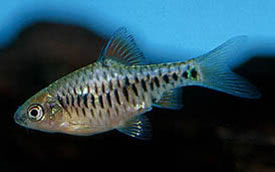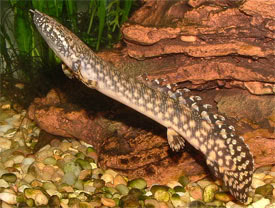
 Magyarul / Hungarian
Magyarul / Hungarian
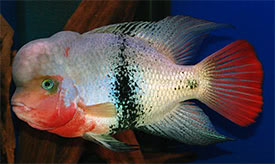
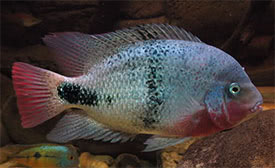
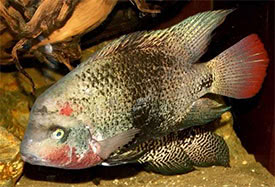
- Scientific name: Paraneetroplus maculicauda
- Synonyms: Cichlasoma maculicauda, Theraps maculicauda, Vieja maculicauda, Cichlasoma nigritum, Cichlasoma globosum, Cichlasoma manana, Vieja panamensis
- Common name: Black Belt Cichlid
- Group: Cichlids
- Habitat: Central America; Guatemala, Honduras, Nicaragua, Costa Rica, Panama.
- Size: 25-30 cm.
- Biotope: Found in slow-moving rivers, and lakes especially over muddy or sandy substrate, where they live among submerged trees and logs. In these habitats the aquatic vegetation is usually dense. Some populations can be found in brackish water or even full marine water.
- Social behavior: Black Belt Cichlid are quite territorial and aggressive fish, and should be kept only with similar sized fish with the same temperament.
- Diet: Almost exclusively herbivorous, feeds on benthic detritus consisting of vegetable matter, both aquatic and terrestrial plants, seeds and fruits.
- Breeding: Quite easy when a pair formed
- Tank: Minimum 250 litres
- Population: 3-4 fish for 600 litres
- Decoration: The fish prefer sandy substrate tanks with plenty of hiding places, so put some driftwoods and roots into the aquarium. They do not like bright lights, so use floating plants to help dim the light.
- Temperature: 22-27 °C
- pH: 6-8
- Hardness: 8-16 NK°
- Lifespan: 8-10 years
Description: Paraneetroplus maculicauda gets its common name from the vertical black stripe on its flank, and the name also refers to its toughness. The fish has oval disk shape body with pointed anal and dorsal fins. The males are silvery white with a black band, either solid or sketchy on their flanks, just behind the pelvic fin. The caudal fin is all red or partially red, and there is red blotching on the throat that runs from the lips to the pelvic fin. The female is dark gray in color with a red tail and black dots. Because of its large distribution area in the wild, there are several color morphs.
The easiest way to get a breeding pair is to buy 5-6 juvenile fish and let them pair off. When a pair has been found, remove the other fish. Males are larger with more vivid coloration, and they also develop a nuchal hump on their head.
Paraneetroplus maculicauda reach their sexual maturity at around 15 centimetres in size, when the fish are 12-16 months old. The female lays 500 to 600 eggs on a flat rock or a similar object in the aquarium. The parents guard the eggs aggressively and clean them with their mouths. The eggs hatch in 2 to 3 days and the parents move them to a previously created spawning pit. After a week the fry become free-swimming. The fry can be fed with brine shrimp nauplii.




